8 Sustainable Packaging Trends on the rise this year
Sustainable Packaging Trends 2022:
The words “eco-friendly” and “sustainable” have become quite synonymous with brand campaigns. These buzzwords are used in brand campaigns to promote their credentials.
While some companies just use these terms to green-wash the brand, others are taking some impactful steps. Innovation with packaging materials and packaging techniques is done to improve sustainability.
Let’s look at some of the most exciting sustainable packaging trends in the industry.
#1 Reducing microplastics
Sometimes we see a packaging complete with a 100% recyclable double wall cardboard boxes. It appears completely clean. But when you unbox, you find microplastics. Styrofoam is one of the biggest examples.
Ironically to its name, microplastics are one of the biggest problems in climate change. They sip into the water bodies easily and harm our entire ecosystem.
Companies are developing better alternatives like corrugated inserts. These are equally effective and a cost-saving alternative to foam inserts.
#2 Reduce, reuse, and recycle
The phrase was coined around 1970. It is still pretty relevant, especially with packaging materials. Brands are finding eco-friendly bubble wrap rolls which can be reused and recycled.
Instead of using multiple layers of small bubble wraps, stick to large bubble wrap rolls. Minimal packaging reduces waste. It is reusable and won’t sacrifice the purpose of packaging—product protection.
#3 Biodegradable packaging
Compostable packaging contains raw materials that come from renewable sources. They break down naturally into the environment without causing an adverse effect on the ecosystem.
Many companies focus on developing customised biodegradable packaging. They use recyclable cardboard boxes, packaging paper and paper-based packing tapes. More and more retail brands have started to adopt this packaging in hopes of reducing their carbon footprint.
#4 Use of bioplastics
The major advantage plastic packaging material is their durability. Sometimes it becomes essential to use plastic packaging for maximum protection.
To replace harmful plastics, distributors like Packaging Midlands are stocking bio-friendly plastic packaging supplies. Biodegradable bubble wraps and eco-friendly loose fillers are some examples. These aren’t 100% recyclable, but they are better at lowering carbon footprints.
#5 Moving towards flexible packaging
Rigid packaging supplies like plastics or glass have a higher density. This makes them expensive to manufacture and produces higher emissions. Brands are gradually moving towards flexible packaging.
Flexible packaging usually consists of paper pulp. These include Kraft paper envelopes, corrugated cardboard rolls and likewise. The idea is to develop packaging that will lower the manufacturing cost and reduce emissions. It also makes packing easier. Companies can ship multiple products at once.
#6 Developing antimicrobial packaging materials
A concern with food and perishable items is that they can get contaminated easily. Scientists are trying for alternative packing materials that will prevent bacterial contamination.
These packing materials help towards sustainability; kill, or prevent the growth of harmful microorganisms and extend product shelf-life.
#7 Increasing use of paper
An alternative to plastic packaging is paper. It has been in the industry for so many decades. However, efforts are now given to developing a paper-based packaging market.
Paper packaging is making great development to become a reliable source. Other innovations include bamboo paper, organic cotton, corn starch and stone paper. However, a lot of work is necessary to make them as sturdy as plastic packaging.
#8 Using eco-friendly inks
So, we made great progress in using alternative sustainable packaging solutions. But what about the other products used in packaging. For instance, inks. Brands use a large amount of ink for graphics and information on the packaging.
Sadly, those inks are harmful to the environment. Sometimes packages cannot be recycled due to the use of harmful inks. Over the last year, a rise in vegetable-based inks and soy inks is seen a lot in the market. These inks are biodegradable and release a significantly less amount of toxic chemicals.
Completely reversing decades of practice is difficult. But we are making massive progress toward a better world. If your company still uses plastic-based packaging, it is time to think differently. The point is to start with small but definitive steps. Gradually, you can change to alternative packaging.




